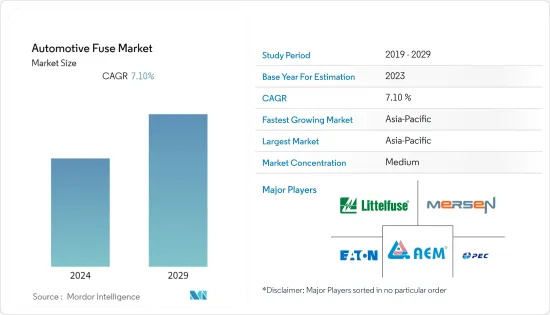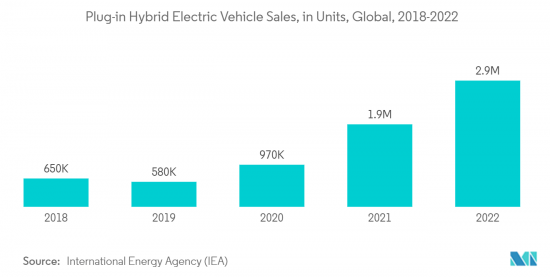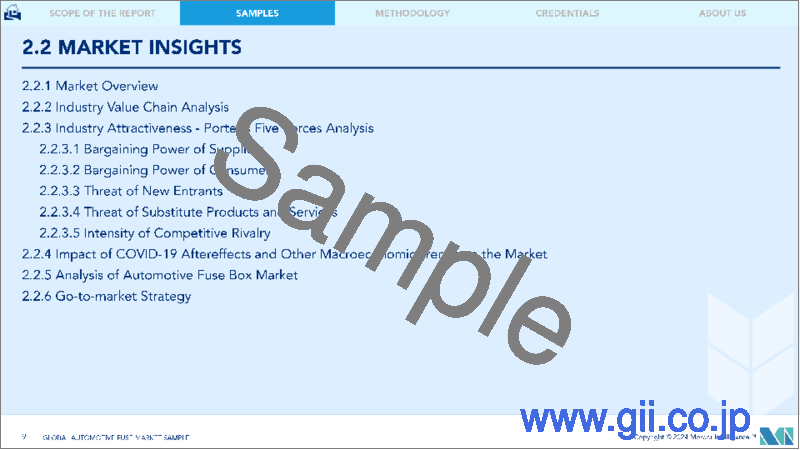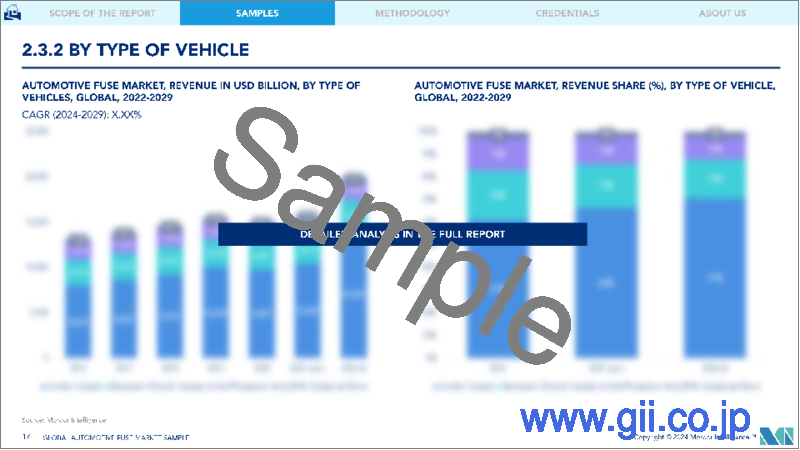|
|
市場調査レポート
商品コード
1407066
自動車用ヒューズ:市場シェア分析、産業動向と統計、2024~2029年の成長予測Automotive Fuse - Market Share Analysis, Industry Trends & Statistics, Growth Forecasts 2024 - 2029 |
||||||
|
● お客様のご希望に応じて、既存データの加工や未掲載情報(例:国別セグメント)の追加などの対応が可能です。 詳細はお問い合わせください。 |
|||||||
| 自動車用ヒューズ:市場シェア分析、産業動向と統計、2024~2029年の成長予測 |
|
出版日: 2024年01月04日
発行: Mordor Intelligence
ページ情報: 英文 120 Pages
納期: 2~3営業日
|
- 全表示
- 概要
- 目次
自動車用ヒューズ市場の前年の市場規模は203億米ドルで、予測期間中のCAGRは7.1%を記録し、今後5年間で306億4,000万米ドルに達すると予測されています。
この市場は、自動車生産の増加、電動化の進展、乗用車における安全性と快適性の重要性の高まりなど、いくつかの要因によって近い将来に拡大すると予想され、これらすべての要因によって、自動車1台当たりのヒューズ取り付け数が増加し、電気自動車やハイブリッドカーの販売が増加します。

ヒューズユニットは、自動車の電気部品の中で最も使用頻度が高く、需要も多いです。高度な技術的品質を備えた自動車への需要が急増していることが、その背景にあると考えられます。自動車メーカーは、消費者の需要増に対応するため、これらの自動車の生産を強化しています。
さらに、燃料価格の上昇や環境への配慮が、最新の自動車技術革新を早めています。より多くの電子機能が統合された電気自動車が普及しつつあり、ヒューズはその開発においてますます重要な役割を果たしています。新興国からの自動車需要の増加により、自動車メーカーはより優れたシステムを開発するようになり、信頼性の高い自動車用ヒューズ市場への要求が高まっています。例えば、IBEFによると、インドの電気自動車市場は2025年までに70億9,000万米ドルに達すると推定されています。
また、各国で販売される電気自動車の数も大幅に増加しています。CAAMによると、2022年4月の中国の新エネルギー車販売台数は29万9000台で、うち28万台が電気乗用車(EV)、1万9,000台が商用EVだった。乗用バッテリー電気自動車(BEV)の販売台数は21万2,000台、プラグインハイブリッド電気自動車(PHEV)の販売台数は6万8,000台でした。
さらに、2022年8月、ゼネラルモーターズは、電気自動車用電池材料に関する3つの新たな調達契約を締結しました。LG化学、ポスコ・ケミカル、リベントとの複数年契約は、リチウム、ニッケル、コバルト、正極活物質(CAM)などの重要材料をGMに供給します。EV産業のバリューチェーンにおけるこのような拡大は、市場において自動車用ヒューズの大きな需要をさらに生み出す可能性があります。
さらに、自動車部門が増加しているため、調査対象市場は予測期間中に成長すると予想されます。例えば米国では、充電可能な小型電気自動車の販売台数が前年の30万8,000台から60万8,000台に増加しています。バッテリー電気自動車は、最近国内で販売された充電式電気自動車全体の73%以上を占めました。
しかし、低電圧ヒューズ分野の開拓が限定的であることや、自動車用ヒューズのアフターマーケットが未組織であることなどの要因が、研究市場の成長への課題を続けています。さらに、原材料価格の変動も市場成長の主要阻害要因のひとつです。
自動車産業は、マクロ経済的要因の影響が大きい主要産業のひとつであり、消費者である自動車は通常、経済が安定した場合に自動車に投資します。しかし、パンデミックの発生以来、世界中の経済は不確実性に直面しており、様々な地域で自動車需要の鈍化が続いています。例えば、2022年の米国の軽自動車販売台数は、2019年の1,696万1,100台から1,375万4,300台に減少しました。北米地域には景気後退の脅威が迫っており、このような動向は少なくとも数年間は持続すると予想され、その結果、調査対象市場の成長も鈍化する可能性があります。
自動車用ヒューズ市場の動向
電気自動車/ハイブリッド車が大きな成長を遂げると予測
- 現在、自動車の電動化の動向が加速しています。世界各国の政府は、内燃機関車やハイブリッド車から全電気自動車への移行を進めており、電力系統の運用に影響を与えています。これは、汚染物質の排出と化石燃料への依存を減らすために、将来のシステム強化において多くの可能性を開くと予想されます。その結果、自動車の電動化の動向は、自動車用ヒューズボックスなどの自動車部品の売上を押し上げると予想されます。
- IEAによると、2050年までのネット・ゼロ・エミッション・シナリオでは、2030年には電気自動車保有台数が3億台を超え、新車販売の60%を電気自動車が占めると予想されています。中国や欧州などの国々がEV競争をリードしており、他の地域でもEVの普及率が高まっています。
- インセンティブや義務化もEV需要を押し上げています。各国政府が自動車の排出量削減に力を入れる中、電気自動車の販売を促進するためにいくつかのインセンティブを提供しています。さらに、EPAとNHTSAは、SAFE(Safer Affordable Fuel-Efficient Vehicles)規則(2021~2026年)の実施を提案しています。これらの法律は、小型商用車と乗用車の企業平均燃費基準と温室効果ガス(GHG)排出量を設定する可能性があります。ゼロ・エミッション車計画は、クリーンでゼロ・エミッションの自動車(ハイブリッド車、電気自動車、燃料電池を搭載した商用車と乗用車)を正確な台数販売することをOEMに義務付けるものです。ZEV計画は、2030年までに1,200万台のZEVを走らせることを目標としています。
- したがって、電気自動車市場の大幅な成長は、運用モデルにおけるより多くのヒューズの統合と並んで、予測期間中に調査市場の需要を加速させると予想されます。近年、いくつかの大手自動車メーカーも、既存の生産能力を転換し、新たな製品ラインを確立することで、完全な電気自動車への移行を促進する意向を表明しています。例えば、Toyotaはバッテリー電気自動車(BEV)30モデルの発売を宣言し、2030年までにEVの年間販売台数350万台の達成を目指しています。Lexusは、2035年までに100%BEVを世界で販売することを目指しました。Volkswagenは、2030年までに欧州で70%、中国で50%、米国で100%の電気自動車販売を達成し、2040年にはほぼすべての電気自動車がゼロ・エミッションになると予測しています。このような動向は、研究対象市場の成長に有利な展望を生み出しています。
- また、ハイブリッド電気自動車の普及も、より多くの電気ユニットを搭載することで、これらの自動車に使用される自動車用ヒューズの数が大幅に増加するため、調査対象市場を支えています。IEAによると、最新のプラグインハイブリッド電気自動車は2022年に世界で約290万台販売されます。プラグインハイブリッド電気自動車(PHEV)の販売台数は、2022年のEV販売台数の約28.4%を占めました。一方、バッテリー電気自動車は同年の世界販売台数の大半を占めました。

アジア太平洋が大きな成長率を記録する見込み
- アジア太平洋は、インド、中国、日本などの国々に著名な自動車メーカーが複数存在することから、自動車用ヒューズ市場の重要な位置を占め、予測期間中にかなりの成長率を記録すると予想されます。同地域では政府の取り組みも拡大しており、電気自動車市場の成長を後押ししています。例えば、インド政府の「Automotive Mission Plan 2016-26」は、インド政府とインドの自動車企業が共同で、自動車産業発展のためのロードマップを策定するものです。さらにインド政府は、自動車部門が2023年までに国内外から80億~100億米ドルの投資を集めると見込んでいます。
- こうした動向に後押しされ、インドの自動車メーカーも取り組みを拡大しており、同国のEVエコシステム全体の発展に貢献しています。例えば、2022年12月、Mahindra & MahindraはプネーにあるEV製造工場に12億米ドルを投資しました。さらに2022年9月には、Hero MotoCorpがカリフォルニアに本拠を置くZero Motorcyclesに6,000万米ドルを投資し、電動バイクの開発で協力すると発表しました。
- 各国の政府も同様の取り組みを進めており、自動車の電動化に向けた取り組みを強化するよう自動車メーカーに働きかけています。例えば、中国の自動車メーカー数社は、2030年のカーボンピーキング目標に合わせて変革を進めています。中国の大手自動車メーカーである東風は、2024年までに新型乗用車の100%を電動化する意向です。2022年に同じく中国の自動車会社であるBYDは、将来的にBEVとPHEVのみを生産すると発表しました。
- さらに、インド政府は、急速な都市化に伴い、排出ガス削減とeモビリティを実現するため、インドでの電気自動車の製造と普及を促進するさまざまな取り組みを開始しました。政府は最近、FAME計画の第2段階を2024年まで延長すると発表しました。このフェーズでは、Eバス、電動三輪車、電動乗用車、電動二輪車への補助を通じて、公共交通と共有交通の電化に重点を置く。
- 例えば、Skoda Autoは最近、インドで電気自動車を製造する計画を発表しました。しかし、現地生産を確約する前に、同社初のEVであるEnyaqをCBUとして市場に投入する可能性があります。Hyundaiは2023年5月、インドのタミル・ナードゥ州に今後10年間で24億5,000万米ドルを投資し、同国でのEV生産を拡大すると発表しました。したがって、こうした動向は予測期間中、アジア太平洋における自動車用ヒューズの需要を促進すると予想されます。
自動車用ヒューズ産業概要
自動車用ヒューズ市場は、地元メーカーが自動車用ヒューズ市場において多数存在するため、適度に断片化されています。同市場の主要企業には、Eaton Corporation、Little Fuse Inc.、Pacific Engineering Corporation、Mersen Electric Power、AEM Components USA Inc.などが含まれます。
2023年 7月、Littelfuse, Inc.は最新のAEC-Q200 Rev E適合ヒューズを発表しました。この新しい製品ポートフォリオには、電気自動車や小型の自動車用電子機器用途の厳しい回路保護ニーズ向けに特別に設計された薄膜ヒューズ、PICOヒューズ、Nano2ヒューズ、とカートリッジヒューズが含まれ、過酷な自動車環境における長期的な信頼性を確保するため、すべての製品がAEC-Q200 Rev E適合認定を取得しています。
2022年12月、BelグループのBel Power Solutionsは、電気自動車(EV)、電気エネルギー貯蔵(EES)、ハイブリッド車などの用途に適した車載用ヒューズの新ラインナップを発売すると発表しました。同社によると、この製品ラインのリリースにより、同社は業界で唯一、500Vと1,000Vの完全な製品を提供するサプライヤーとなります。
その他の特典:
- エクセル形式の市場予測(ME)シート
- 3ヶ月間のアナリスト・サポート
目次
第1章 イントロダクション
- 調査の前提条件と市場の定義
- 調査範囲
第2章 調査手法
第3章 エグゼクティブサマリー
第4章 市場洞察
- 市場概要
- 産業バリューチェーン分析
- 業界の魅力度-ポーターのファイブフォース分析
- 買い手の交渉力
- 供給企業の交渉力
- 新規参入業者の脅威
- 代替品の脅威
- 競争企業間の敵対関係の強さ
- マクロ経済動向の市場への影響
第5章 市場力学
- 市場促進要因
- 自動車新時代の進化-電動化と自動化
- 自動車への電気・電子ユニット搭載の増加
- 市場抑制要因
- ヒューズ市場における低電圧ヒューズ分野の限定的開拓と未組織アフターマーケット
第6章 市場セグメンテーション
- タイプ別
- ブレード
- ガラス
- スローブロー
- 高電圧ヒューズ
- その他のタイプ
- 車種別
- 乗用車(従来型-ICE)
- 商用車(従来型-ICE)
- 電気自動車/ハイブリッド車
- 地域別
- 北米
- 米国
- カナダ
- 欧州
- フランス
- ドイツ
- スペイン
- その他の欧州
- アジア太平洋
- 中国
- 日本
- インド
- その他のアジア太平洋
- ラテンアメリカ
- ブラジル
- メキシコ
- その他のラテンアメリカ
- 中東・アフリカ
- 北米
第7章 競合情勢
- 企業プロファイル
- Pacific Engineering Corporation
- Little Fuse Inc.
- Eaton Corporation
- Mersen Electrical Power
- AEM Components(USA), Inc.
- E-T-A ElektrotechnischeApparateGmbH
- OptiFuse
- Bel Fuse Inc.
第8章 投資分析
第9章 市場の将来

The Automotive Fuse Market was valued at USD 20.3 billion in the previous year and is expected to register a CAGR of 7.1 percent during the forecast period to reach USD 30.64 billion by the next five years. The market is expected to expand in the near future due to several factors, including increased vehicle production, elevated electrification, and the rising importance of safety and comfort features in passenger vehicles, all of which will lead to an increase in the number of fuses installed per vehicle and increased sales of electric and hybrid cars.
Fuse units are the most frequently used and demanded of all the electrical elements in a car. The surge in demand for vehicles with advanced technical qualities can be attributed to this. Automobile manufacturers are ramping up the production of these vehicles to satisfy increased consumer demand.
Furthermore, rising fuel prices and environmental concerns are hastening the latest automotive innovations. Electric vehicles with more integrated electronic features are becoming more popular, and fuses play an increasingly important role in their development. The increased demand for automobiles from emerging nations has prompted automakers to develop better systems, raising the requirement for a reliable automotive fuse market. For instance, according to IBEF, India's electric vehicle market is estimated to reach USD 7.09 billion by 2025.
There's also been a massive increase in the number of electric vehicles on sale in various countries. According to CAAM, in April 2022, China's new energy vehicle sales amounted to 299,000 units, of which 280,000 were electric passenger vehicles (EVs) and 19,000 were commercial electric vehicles. Sales of passenger battery electric vehicles (BEVs) and plug-in hybrid electric vehicles (PHEVs) were 212,000 and 68,000 units, respectively.
In addition, in August 2022, General Motors signed three new sourcing agreements for electric vehicle battery materials, which may help the automaker meet its goal of producing 1mm electric vehicles yearly. The multi-year contracts with LG Chem, POSCO Chemical, and Livent will supply GM with critical materials such as lithium, nickel, cobalt, and cathode active material (CAM). Such expansion in the EV industry value chain may further create significant demand for automotive fuse in the market.
Furthermore, the studied market is expected to grow in the forecasted period because the automotive sector is increasing. For instance, in the United States, sales of renewed light-duty chargeable electric cars increased to 608,000 recently compared to 308,000 in the previous year. Battery electric vehicles accounted for more than 73 percent of the total chargeable electric cars sold in the country recently.
However, factors such as limited development achieved in the field of low-voltage fuses and the presence of an unorganized aftermarket for automotive fuses continue to challenge the studied market's growth. Additionally, the fluctuating raw material prices is also among the major restraining factor for the growth of the studied market.
The automotive industry is among the leading industries wherein the influence of macroeconomic factors is high, as automobiles as consumers usually invest in automobiles in case of economic stability. However, economies across the world are facing uncertainty since the outbreak of the pandemic, which continues to slow down the demand for automobiles across various regions. For instance, in 2022, the sales of light vehicles in the United States reduced to 13,754.3 thousand units compared to 16,961.1 thousand units in 2019. With the threat of recession looming over the North American region, such trends are anticipated to sustain at least for a few years, which in turn may also slow down the growth of the studied market.
Automotive Fuse Market Trends
Electric/Hybrid Vehicles is Anticipated to Grow at Major Rate
- Currently, the trend toward vehicle electrification is attaining traction. Governments worldwide are transitioning from internal combustion and hybrid cars to all-electric vehicles, which impacts power system operations. This is anticipated to open up many possibilities in future system enhancements to decrease pollutant emissions and reliance on fossil fuels. As a result, the trend toward car electrification is anticipated to boost sales of automobile components, such as automotive fuse boxes.
- According to IEA, the net-zero emissions by 2050 Scenario sees an electric vehicle fleet of over 300 million in 2030 and electric vehicles accounting for 60 percent of new car sales. Countries such as China and the European region are leading the EV race, with other regions increasing their EV adoption rate.
- Incentives and mandates are also boosting the demand for EVs. Governments are delivering several incentives to boost electric car sales as nations focus on reducing vehicle emissions. Further, the EPA and NHTSA proposed implementing the Safer Affordable Fuel-Efficient (SAFE) vehicles rules (2021-2026). These laws may set corporate average fuel economy standards and greenhouse gas (GHG) emissions for light, commercial, and passenger vehicles. The Zero Emission Vehicles Program requires OEMs to sell exact numbers of clean and zero-emission automobiles (hybrid, electric, and fuel cell-powered commercial and passenger cars). The ZEV plan desires to put 12 million ZEVs on the road by 2030.
- Hence, the significantly growing electric vehicle market, alongside the integration of more fuses in the operational models, is anticipated to accelerate the demand in the studied market during the forecast period. Several major automakers have also stated in recent years that they intend to expedite the transition to a fully electric future by converting existing manufacturing capacity and establishing new product lines. For instance, Toyota declared the launch of 30 battery electric vehicle (BEV) models, aiming to reach 3.5 million annual EV sales by 2030. Lexus desired to sell 100% BEVs globally by 2035. By 2030, Volkswagen anticipated all-electric car sales to approach 70 percent in Europe, 50 percent in China, and 100 percent in the United States, with nearly all zero-emission motorcars by 2040. Such trends create a favorable outlook for the growth of the studied market.
- The growing proliferation of hybrid electric vehicles also supports the studied markets, as the inclusion of more electrical units significantly enhances the number of automotive fuses used in these vehicles. According to IEA, about 2.9 million of the latest plug-in hybrid electric cars were sold worldwide in 2022. Plug-in hybrid electric vehicle (PHEV) sales accounted for approximately 28.4 percent of EV sales in 2022. Meanwhile, battery electric cars accounted for most of the global sales that year.

Asia-Pacific is Expected to Register a Significant Growth Rate
- Asia-Pacific is expected to hold a significant automotive fuse market, with a considerable growth rate over the forecasted period, owing to the presence of several prominent car manufacturers in nations such as India, China, and Japan. The region's expanding government efforts are also aiding the electric vehicle market's growth. For instance, the Indian government's Automotive Mission Plan 2016-26 is a joint initiative by the Government of India and the Indian automotive firms to lay down the roadmap for the development of the industry. Further, the government of India expects the automobile sector to attract USD 8-10 billion in local and foreign investments by 2023.
- Driven by such trends, Indian automotive manufacturers are also extending their efforts, which is contributing to the overall development of the EV ecosystem in the country. For instance, in December 2022, Mahindra & Mahindra invested USD 1.2 billion in an EV manufacturing plant in Pune. Further, in September 2022, Hero MotoCorp announced an investment of USD 60 million in California-based Zero Motorcycles to collaborate on developing electric motorcycles.
- Governments across various countries are taking similar initiatives, encouraging automobile manufacturers to enhance their efforts towards the electrification of vehicles. For instance, several automakers in China are making changes to match the 2030 carbon peaking aim. By 2024, Dongfeng, a leading automobile manufacturer in China, intends to electrify 100 percent of its new passenger car models. BYD, another Chinese automotive company in 2022, announced that they will only produce BEVs and PHEVs in the future.
- Furthermore, the government of India has launched various initiatives to facilitate the manufacturing and adoption of electric cars in India to reduce emissions and create e-mobility in the wake of rapid urbanization. The government recently announced an extension of phase two of the FAME scheme through 2024. This phase focuses on electrifying public and shared transportation through subsidizing e-buses, electric three-wheelers, electric passenger vehicles, and electric two-wheelers.
- For instance, Skoda Auto recently announced its plan to manufacture electric vehicles in India. However, before committing to local manufacture, the company might bring its first EV, the Enyaq, to market as a CBU. In May 2023, Hyundai announced a USD 2.45 billion investment in the state of Tamil Nadu, India, over the next ten years to drive the production growth of EVs in the country. Hence, such trends are anticipated to drive the demand for automotive fuse in the Asia Pacific region during the forecast period.
Automotive Fuse Industry Overview
The Automotive Fuse Market is moderately fragmented due to local manufacturers' availability in large numbers in the automotive fuse market landscape. The significant players in the market include Eaton Corporation, Little Fuse Inc., Pacific Engineering Corporation, Mersen Electric Power, and AEM Components USA Inc., among others.
In July 2023, Littelfuse, Inc. released its latest AEC-Q200 Rev E Qualified Fuses. Designed specifically for the demanding circuit protection needs of electric vehicles and compact automotive electronics applications, the new product portfolio includes a range of thin film fuses, PICO fuses, Nano2 fuses, and cartridge fuses, all certified to meet the AEC-Q200 Rev E qualifications to ensure the long-term reliability in harsh automotive environments.
In December 2022, Bel Power Solutions, a Bel group company, announced the availability of a new line of automotive fuses suitable for applications in electric vehicles (EVs), electrical energy storage (EES), and hybrid vehicles. According to the company, the release of this line makes the company the only supplier in the industry showing a complete 500V and 1000V offering.
Additional Benefits:
- The market estimate (ME) sheet in Excel format
- 3 months of analyst support
TABLE OF CONTENTS
1 INTRODUCTION
- 1.1 Study Assumptions and Market Definitions
- 1.2 Scope of the Study
2 RESEARCH METHODOLOGY
3 EXECUTIVE SUMMARY
4 MARKET INSIGHTS
- 4.1 Market Overview
- 4.2 Industry Value Chain Analysis
- 4.3 Industry Attractiveness - Porter's Five Forces Analysis
- 4.3.1 Bargaining Power of Buyers
- 4.3.2 Bargaining Power of Suppliers
- 4.3.3 Threat of New Entrants
- 4.3.4 Threat of Substitute Products
- 4.3.5 Intensity of Competitive Rivalry
- 4.4 Impact of Macroeconomic Trends on the Market
5 MARKET DYNAMICS
- 5.1 Market Drivers
- 5.1.1 Evolution of New Automotive Era -Electrification and Autonomy
- 5.1.2 Increasing Incorporation of Electrical and Electronic Units in Automobiles
- 5.2 Market Restraints
- 5.2.1 Limited Development in the Field of Low-Voltage Fuses and Unorganized Aftermarket in the Fuse Market
6 MARKET SEGMENTATION
- 6.1 By Type
- 6.1.1 Blade
- 6.1.2 Glass
- 6.1.3 Slow Blow
- 6.1.4 High-Voltage Fuses
- 6.1.5 Other Types
- 6.2 By Type of Vehicle
- 6.2.1 Passenger Cars (Traditional -ICE)
- 6.2.2 Commercial Vehicles (Traditional -ICE)
- 6.2.3 Electric/Hybrid Vehicles
- 6.3 By Geography
- 6.3.1 North America
- 6.3.1.1 United States
- 6.3.1.2 Canada
- 6.3.2 Europe
- 6.3.2.1 France
- 6.3.2.2 Germany
- 6.3.2.3 Spain
- 6.3.2.4 Rest of Europe
- 6.3.3 Asia-Pacific
- 6.3.3.1 China
- 6.3.3.2 Japan
- 6.3.3.3 India
- 6.3.3.4 Rest of the Asia-Pacific
- 6.3.4 Latin America
- 6.3.4.1 Brazil
- 6.3.4.2 Mexico
- 6.3.4.3 Rest of the Latin America
- 6.3.5 Middle-East and Africa
- 6.3.1 North America
7 COMPETITIVE LANDSCAPE
- 7.1 Company Profiles
- 7.1.1 Pacific Engineering Corporation
- 7.1.2 Little Fuse Inc.
- 7.1.3 Eaton Corporation
- 7.1.4 Mersen Electrical Power
- 7.1.5 AEM Components (USA), Inc.
- 7.1.6 E-T-A ElektrotechnischeApparateGmbH
- 7.1.7 OptiFuse
- 7.1.8 Bel Fuse Inc.




